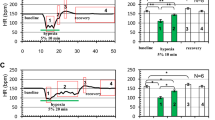Summary
By using a whole-embryo culture technique (New 1978), the effects of oxygen concentration (5%, 20% and 95% oxygen) on embryonic development in the rat were investigated by light and electron microscopy. The best embryonic development occurred when the 9.5-day-old embryos were cultured for 24 h with 5% oxygen, and the 10.5-day-old embryos with 20% oxygen (optimum oxygen concentration). When the 9.5- and 10.5-day-old embryos were cultured for 24 h with too little or too much oxygen, retardation of the embryonic growth and abnormal development was observed. Using light microscopy, numerous degenerating cells, exhibiting granular deposits in the cytoplasm, were seen, but the distribution of the degenerating cells was quite different between the two groups. With electron microscopy, the most striking feature of the degenerating cells in the embryos cultured with too little oxygen, was the extreme swelling of the mitochondria without any morphological alterations of the nucleus or the other cell organelles. On the other hand, the characteristic feature of the degenerating cells in the embryos exposed to too much oxygen, was the formation of phagolysosomes in the cytoplasm. Morphological alterations of the nucleus or mitochondria were not evident. In the present study, the possible teratogenic mechanism of too much or too little oxygen in the whole-embryo culture of the rat embryo is discussed.
Similar content being viewed by others
References
Brown NA, Fabro S (1981) Quantitation of rat embryonic development in vitro: A morphological scoring system. Teratology 24:65–78
Hettwer H, Claussen U, Servos G (1985) Die Wirkung von Cyclophosphamid auf das Neuralrohrgewebe von Kaninchenembryonen während der histiotrophen Phase der Ernährung. Z Mikrosk Anat Forsch 99:866–876
Horton WE, Sadler TW (1983) Effects of maternal diabetes on early embryogenesis: Alterations in morphogenesis produced by keton body, β-hydroxybutyrate. Diabetes 32:610–616
Horton WE, Sadler TW (1985) Mitochondrial alterations in embryos exposed to β-hydroxybutyrate in whole embryo culture. Anat Rec 213:94–101
Kugler P, Miki A (1985) Study on membrane recycling in the rat yolk-sac endoderm using concanavalin A conjugates. Histochemistry 83:359–367
Laiho KU, Trump BF (1975) Studies on the pathogenesis of cell injury. Effects of inhibitors of metabolism and membrane function on the mitochondria of Ehrlich ascites tumor cells. Lab Invest 32:163–182
Miki A, Kugler P (1984) Comparative enzyme histochemical study on the visceral yolk sac endoderm in the rat in vivo and in vitro. Histochemistry 81:409–415
Miki A, Mizoguchi A, Mizoguti H (1988) Histochemical studies of enzymes of the energy metabolism in postimplantation rat embryos. Histochemistry 88:489–495
Morris GM, New DAT (1979) Effect of oxygen concentration on morphogenesis of cranial folds and neural crest in cultured rat embryos. J Embryol Exp Morphol 54:17–35
New DAT (1978) Whole-embryo culture and the study of mammalian embryos during organogenesis. Biol Rev 53:81–122
New DAT, Coppola PT (1970) Effects of different oxygen concentrations on the development of rat embryos in culture. J Reprod Fertil 21:109–118
New DAT, Coppola PT (1977) Development of a placental circulation in rat embryos in vitro. J Embryol Exp Morphol 37:227–235
New DAT, Coppola PT, Cockroft DL (1976a) Improved development of head-fold rat embryos in culture resulting from low oxygen and modifications of the culture system. J Reprod Fertil 48:219–222
New DAT, Coppola PT, Cockroft DL (1976b) Comparison of growth in vitro and in vivo of post-implantation rat embryos. J Embryol Exp Morphol 36:133–144
New DAT, Coppola PT, Terry S (1973) Culture of explanted rat embryos in rotating tubes. J Reprod Fertil 35:135–138
Sadler TW, Cardell RR (1977) Ultrastructural alterations in neuroepithelial cells of mouse embryos exposed to cytotoxic dose of hydroxyurea. Anat Rec 188:103–124
Schweichel J-U, Merker H-J (1973) The morphology of various types of cell death in prenatal tissues. Teratology 7:253–266
Steele CE, New DAT (1974) Serum variants causing the formation of double hearts and other abnormalities in explanted rat embryos. J Embryol Exp Morphol 31:707–719
Trujillo CM, Yanes CM, Marrero A, Perez MA, Martin JM (1987) Cell death in the embryonic brain ofGallotia galloti (Reptilia; Lacertidae): a structural and ultrastructural study. J Anat 150:11–21
Author information
Authors and Affiliations
Rights and permissions
About this article
Cite this article
Miki, A., Fujimoto, E., Ohsaki, T. et al. Effects of oxygen concentration on embryonic development in rats: a light and electron microscopic study using whole-embryo culture techniques. Anat Embryol 178, 337–343 (1988). https://doi.org/10.1007/BF00698664
Accepted:
Issue Date:
DOI: https://doi.org/10.1007/BF00698664




